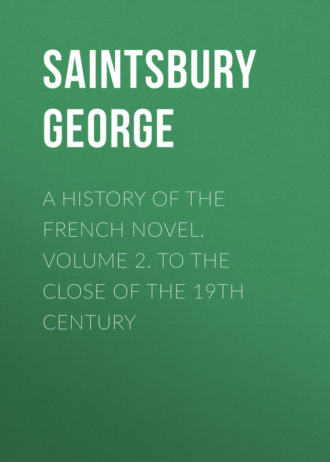 полная версия
полная версияA History of the French Novel. Volume 2. To the Close of the 19th Century
It ought, however, to be said that Armance is an early and remarkable Romantic experiment in several ways, not least in the foreign mottoes, English, Portuguese, Spanish, and German, which are prefixed to the chapters. Unluckily some of them129 are obviously retranslated from French versions unverified by the originals, and once there is a most curious blunder. Pope's description of Belinda's neck and cross, not quite in the original words but otherwise exact, is attributed to – Schiller!
La Chartreuse de Parme.
I have read, I believe, as much criticism as most men, possibly, indeed, a little more than most, and I ought long ago to have been beyond the reach of shocking, startling, or any other movement of surprise at any critical utterance whatsoever. But I own that an access of fou rire once came upon me when I was told in a printed page that La Chartreuse de Parme was a "very lively and very amusing book." A book of great and peculiar power it most undoubtedly is, a book standing out in the formidable genealogy of "psychological" novels as (salva reverentia) certain names stand out from the others in the greater list that opens the first chapter of St. Matthew. But "lively"? and "amusing"? Wondrous hot indeed is this snow, and more lustrous than any ebony are the clerestories towards the south-north of this structure.
The Waterloo episode.
The subject and general colour.
To begin with, there rests on the whole book that oppression of récit which has been not unfrequently dwelt upon in the last volume, and sometimes this. Of the 440 pages, tightly printed, of the usual reprint, I should say that two-thirds at least are solid, or merely broken by one or two paragraphs, which are seldom conversational. This, it may be said, is a purely mechanical objection. But it is not so. Although the action is laid in the time contemporary with the writer and writing, from the fall of Napoleon onwards, and in the country (Italy) that he knew best, the whole cast and scheme are historical, the method is that of a lecturer at a panorama, who describes and points while the panorama itself passes a long way off behind a screen of clear but thick glass. In two or perhaps three mostly minute parts or scenes this description may seem unjust. One, the first, the longest, and the best, is perhaps also the best-known of all Beyle's work: it is the sketch of the débâcle after Waterloo. (It is not wonderful that Beyle should know something about retreats, for, though he was not at Waterloo, he had come through the Moscow trial.) This is a really marvellous thing and intensely interesting, though, as is almost always the case with the author, strangely unexciting. The interest is purely intellectual, and is actually increased by comparison with Hugo's imaginative account of the battle itself; but you do not care the snap of a finger whether the hero, Fabrice, gets off or not. Another patch later, where this same Fabrice is attacked by, and after a rough-and-tumble struggle kills, his saltimbanque rival in the affections of a low-class actress, and then has a series of escapes from the Austrian police on the banks of the Po, has a little more of the exciting about it. So perhaps for some – I am not sure that it has for me – may have the final, or provisionally final, escape from the Farnese Tower. And there is, even outside of these passages, a good deal of scattered incident.
But these interesting plums, such as even they are, are stuck in an enormous pudding of presentation of the intrigues and vicissitudes of a petty Italian court,130 in which, and in the persons who take part in them, I at least find it difficult to take the very slightest interest. Fabrice del Dongo himself,131 with whom every woman falls in love, and who candidly confesses that he does not know whether he has ever been really in love with any woman – though there is one possible exception precedent, his aunt, the Duchess of Sanseverina, and one subsequent, Clélia Conti, who saves him from prison, as above – is depicted with extraordinary science of human nature. But it is a science which, once more, excludes passion, humour, gusto – all the fluids of real or fictitious life. Fabrice is like (only "much more also") the simulacra of humanity that were popular in music-halls a few years ago. He walks, talks, fights, eats, drinks, thinks even, and makes love if he does not feel it, exactly like a human being. Except the "fluids" just mentioned, it is impossible to mention anything human that he lacks. But he lacks these, and by not having them lacks everything that moves the reader.
And so it is more or less with all of them: with the Duchess and Clélia least perhaps, but even with them to some extent; with the Duchess's first cicisbeo and then husband, Count Mosca, prime minister of the Duke of Parma; with his master, the feebly cruel and feebly tyrannical Ranuce-Ernest IV.; with the opposition intriguers at court; with the Archbishop, to whom Fabrice is made, by the influence of Count and Duchess, coadjutor and actual successor; with Clélia's father and her very much belated husband – with all of them in short. You cannot say they are "out"; on the contrary they do and say exactly what in the circumstances they would do and say. Their creator's remarks about them are sometimes of a marvellous subtlety, expressed in a laconism which seems to regard Marivaudage or Meredithese with an aristocratic disdain. But at other times this laconic letter literally killeth. Perhaps two examples of the two effects should be given:
(Fabrice has found favour in the eyes and arms of the actress Marietta)
The love of this pretty Marietta gave Fabrice all the charms of the sweetest friendship. And this made him think of the happiness of the same kind which he might have found with the Duchess herself.
If this is not "piercing to the accepted hells beneath" with a diamond-pointed plunger, I know not what is.
But much later, quite towards the end of the book, the author has to tell how Fabrice again and Clélia "forgot all but love" in one of their stolen meetings to arrange his escape.
(He has, by the way, told a lie to make her think he is poisoned)
She was so beautiful – half-dressed and in a state of extreme passion as she was – that Fabrice could not resist an almost involuntary movement. No resistance was opposed.132
Now I am not (see Addenda and Corrigenda of the last volume) avid of expatiations of the Laclosian kind. But this is really a little too much of the "Spanish-fleet-taken-and-burnt-as-per-margin" order.
L'Abbesse de Castro, etc.
Much the same characteristics, but necessarily on a small scale, appear in the short stories usually found under the title of the first and longest of them, L'Abbesse de Castro. Two of these, Mina de Wangel and Le Philtre, are historiettes of the passion which is absent from La Chartreuse de Parme; but each is tainted with the macabre touch which Beyle affected or which (for that word is hardly fair) was natural to him. In one a German girl of high rank and great wealth falls in love with a married man, separates him from his wife by a gross deception, lives with him for a time; and when he leaves her on finding out the fraud, blows her brains out. In the other a Spanish lady, seduced and maltreated by a creole circus-rider of the worst character, declares to a more honourable lover her incurable passion for the scoundrel and takes the veil. The rest are stories of the Italian Renaissance, grimy and gory as usual. Vittoria Accoramboni herself figures, but there is no evidence that Beyle (although he had some knowledge of English literature133) knew at the time our glorious "White Devil," and his story dwells little on her faults and much on the punishment of her murderers. L'Abbesse de Castro itself, La Duchesse de Palliano, San Francesco à Ripa, Vanina Vanini are all of the same type and all full of the gloomier items seen by the Dreamer of Fair Women —
Scaffolds, still sheets of water, divers woes,Ranges of glimmering vaults with iron grates,and blood everywhere. And these unmerry tales are always recounted ab extra; in fact, many of them are real or pretended abstracts from chronicles of the very kind which furnished Browning with the matter of The Ring and the Book. It is, however, more apt and more curious to compare them with the scenes of Gerard's experiences with the princess in The Cloister and the Hearth, as instances of different handling of the same matter by two novelists of talent almost, if not quite, reaching genius.
Le Rouge et le Noir.
This singular aloofness, this separation of subject and spectator by a vast and impenetrable though translucent wall, as in a museum or a morgue, is characteristic of all Beyle's books more or less. In fact, he somewhere confesses – the confession having, as always in persons of anything like his stamp, the nature of a boast – that he cannot write otherwise than in récit, that the broken conversational or dramatic method is impossible to him. But an almost startling change – or perhaps it would be more accurate to say reinforcement – of this method appears in what seems to me by far the most remarkable and epoch-making of his books, Le Rouge et le Noir. That there is a strong autobiographic element in this, though vigorously and almost violently "transposed," must have been evident to any critical reader long ago. It became not merely evident but evidenced by the fresh matter published thirty years since.
Beyle's masterpiece, and why.
The book is a long one; it drags in parts; and, long as it is, there is stuff in it for a much longer – indeed preferably for two or three. It is not only a roman passionnel, as Beyle understood passion, not only a collection of Parisian and Provincial scenes, but a romance of secret diplomacy, and one of Seminarist life, with constant side-excursions of Voltairianism, in religion, of the revolutionary element in politics which Voltaire did not ostensibly favour, however much he may have been responsible for it, of private cynicism, and above all and most consistently of all, of that psychological realism, which is perhaps a more different thing from psychological reality than our clever ones for two generations have been willing to admit, or, perhaps, able to perceive.
That – to adopt a division which foolish folk have sneered at directly and indirectly, but which is valuable and almost necessary in the case of second-class literature – it is rather an unpleasant than a pleasant book, must be pretty well apparent from what has been already said of its author and itself. That it is a powerful one follows almost in the same way. But what has to be said, for the first, if not also the last, time in reference to Beyle's fiction, is that it is interesting.
Julien Sorel and Mathilde de la Mole.
The interest depends almost entirely – I really do not think it would be rash to say entirely – upon the hero and one of the heroines. The other personages are dramatically and psychologically competent, but Beyle has – perhaps save in one or two cases intentionally – made them something of comparses or "supers." There may be two opinions about the other heroine, Madame de Rênal, Julien Sorel's first and last love, his victim in two senses and directly the cause of his death, though he was not directly the cause of hers. She seems to me merely what the French call a femmelette, feebly amorous, feebly fond of her children, feebly estranged from and unfaithful to her husband, feebly though fatally jealous of and a traitress to her lover – feebly everything. Shakespeare or Miss Austen134 could have made such a character interesting, Beyle could not. Nor do the other "seconds" – Julien's brutal peasant father and brothers, the notables of Verrières, the husband, M. de Rênal (himself a gentillâtre, as well as a man of business, a bully, and a blockhead), and the hero's just failure of a father-in-law, the Marquis de la Mole – seem to me to come up to the mark. But, after all, they furnish forth the action, and are necessary in their various ways to set forth the character of that hero and his second love, almost in the mediaeval sense his wife and his widow, Mathilde de la Mole, heiress, great lady, fille folle de son corps, and, in a kind of way, Queen Whims.
Julien Sorel, allowance being made for his date, is one of the most remarkable heroes of fiction. He is physically handsome, in fact beautiful,135 intellectually very clever, and possessed, in especial, of a marvellous memory; also, though not well educated early, capable of learning anything in a very short time – but presented in these favourable lights without any exaggeration. A distinguished Lord Justice was said by his admirers, at the beginning of his manhood, to have obtained more marks in examinations than any youthful person in the United Kingdom: and Julien, with equal opportunities, would probably have done the same in France. Morally, in no limited sense of the word, he does not possess a single good quality, and does possess most bad ones, with the possible exceptions of gluttony and avarice. That, being in each case a family tutor or employé under trust, he seduces the wife of his first employer and the daughter of the second, cannot, in the peculiar circumstances, be said to count. This is, as it were, the starting-point, the necessary handicap, in the competition of this kind of novel. It is as he is, and in reference to what he does, after this is put aside, that he has to be considered. He is not a stage villain, though he has the peculiar, and in the circumstances important, if highly-to-be-deprecated habit of carrying pocket-pistols. He is not a Byronic hero with a terrible but misty past. He is not like Valmont of the Liaisons Dangereuses,136 a professional and passionless lady-killer. He is not a swindler nor (though he sometimes comes near to this also) a conspirator like Count Fosco of The Woman in White. One might make a long list of such negatives if it were worth while. He is only an utterly selfish, arrogant, envious, and generally bad-blooded137 young man, whom circumstances partly, and his own misdeeds helping them, first corrupt and then destroy. You never sympathise with him for one moment, except in a peculiar fashion to be noted presently; but at the same time he neither quite bores you nor quite disgusts you. Homo est, and it is Beyle's having made him so that makes Beyle a sort of genius and much more than a sort of novelist.
But I am not certain that Mathilde is not even a greater creation, though again it is, except quite towards the end, equally impossible to like her. Femina est, though sometimes furens, oftener still furiosa (in a still wider sense than that in which Mr. Norris has138 ingeniously "feminated" Orlando Furioso), and, in part of her conduct already alluded to, as destitute of any morality as Julien himself. Although there could hardly be (and no doubt had better not be) many like her, she is real and true, and there are not a few redeeming features in her artistically and even personally. She is, as has been said, both rich and noble, the famous lover of the third Valois Marguerite being an (I suppose collateral) ancestor of hers.139 Her father is not merely a patrician but a Minister at the close of the French Restoration; she may marry any one she likes; and has, in fact, a train of admirers whom she alternately cajoles and snubs. Julien is taken into the household as half private secretary, half librarian; is especially favoured by her father, and treated by her brother (one of Beyle's few thoroughly good fellows) almost on equal terms. But his bad blood and his want of breeding make him stiff and mysterious, and Mathilde takes a perverse fancy to him, the growth of which is skilfully drawn. Although she is nothing so little as a Lélia or an Indiana or a Valentine (vide next chapter), she is idiosyncratically romantic, and at last it is a case of ladders up to the window, "the irreparable," and various wild performances on her part and her lover's. But this is all comparatively banal. Beyle's touch of genius only reappears later. An extraordinary but (when one comes to think of it) not in the least unnatural series of "ups and downs" follows. Julien's bad blood and vulgar nature make him presume on the advantage he has obtained; Mathilde's morgue and hot-headedness make her feel degraded by what she has given. She neglects him and he becomes quite frantic about her; he takes sudden dudgeon and she becomes frantically desirous of him. This spiritual or emotional man-and-woman-in-the-weather-house business continues; but at last, with ambages and minor peripeteias impossible to abstract, it so comes about that the great and proud Marquis de La Mole, startlingly but not quite improbably, chooses to recognise this traitor and seducer as a possible by-blow of nobility, gets him a commission, endows him handsomely, and all but gives his consent to a marriage.
Then the final revolution comes. With again extraordinary but, as it is told, again not inconceivable audacity, Julien refers for character to his first mistress in both senses, Madame de Rênal, and she "gives him away." The marquis breaks off the treaties, and Julien, leaving his quarters, journeys down to Verrières and shoots Madame de Rênal (with the pocket-pistols) in church. She does not die, and is not even very seriously wounded; but he is tried, is (according, it would seem, to a state of French law, which contrasts most remarkably with one's recent knowledge of it) condemned, and after a time is executed for a murder which has not been committed. Mathilde (who is to bear him a child and always considers herself his wife) and Madame de Rênal both visit him in prison, the former making immense efforts to save him. But Julien, consistently with his character all through, is now rather bored by Mathilde and exceedingly fond of Madame de Rênal, who dies shortly after him. What becomes of Mathilde we are not told, except that she devotes herself to her paulo-post-future infant. The mere summary may seem rather preposterous; the book is in a way so. But it is also, in no ordinary sense, once more real and true. It has sometimes been regarded as a childish, but I believe it to be a true, criterion of novels that the reader should feel as if he would like to have had personal dealings with the personages. I should very much like to have shot140 Julien Sorel, though it would have been rather an honour for him. And I should very much like to have made Mathilde fall in love with me. As for Madame de Rênal, she was only good for suckling fools and telling tales out of school. But I do not find fault with Beyle for drawing her, and she, too, is very human.
In fact the book, pleasant or unpleasant, if we reflect on what the French novel was at the time, deserves a very high place. Compare it with others, and nowhere, except in Balzac, will you find anything like it for firm analysis of character, while I confess that it seems to me to be more strictly human of this world, and at the same time more original,141 than a good deal of the Comédie.
The resuscitated work —Lamiel.
The question, "Would a novelist in altered circumstances have given us more or better novels?" is sometimes treated as ultra vires or nihil ad rem on the critic's part. I myself have been accused rather of limiting than of extending the province of the literary critic; yet I think this question is, sometimes at least, in place. If so, it can seldom be more in place than with Beyle, first because of the unusually mperfect character of his actual published work; and secondly, because of the still more unusual abundance of half-done work, or of fragments of self-criticism, which what has been called the "Beyle resurrection" of the close of the last century has furnished. Indeed the unfinished and scarcely more than half-drafted novel of Lamiel almost by itself suggests the question and supplies the answer. That answer – except from favourers of the grime-novel which, oddly enough, whether by coincidence or common causation became so popular at about the time of this "resurrection" – can hardly be favourable. Lamiel is a very grubby little book. The eponymous heroine is adopted as a child by a parish beadle and his wife, who do not at all maltreat her, except by bringing her up in ways of extreme propriety, which she detests, taking delight in the histories of Mandrin, Cartouche and Co. At early maidenhood she is pitched upon as lectrice, and in a way favourite, by the great lady of the neighbourhood, the Duchess of Miossens; and in this position first attracts the attention of a peculiarly diabolical little dwarf doctor, who, bar the comic142 element, reminds one rather of Quilp. His designs are, however, baulked in a most Beylian manner; for Lamiel (who, by a pleasing chance, was at first called "Amiel" – a delightfully other Amiel!) coolly bestows some money upon a peasant to "teach her what love is," and literally asks the Gebirian question about the ocean, "Is this all?" after receiving the lesson. Further, in the more and more unfinished parts of the book, she levants for a time with the young duke, quits him, becomes a professional hetaera in Paris, but never takes any fancy to the business of her avocation till she meets an all-conquering criminal, Valbayre.143 The scenario tells us that, Valbayre having been caught by justice, she sets fire to the Palace thereof, and her own bones are discovered in the ashes.
This, though Beyle at least meant to season the misanthropy with irony (he might be compared with Meredith for some slightly cryptic views of "the Comic Spirit"), is rather poor stuff, and certainly shows no improvement or likelihood of improvement on the earlier productions. It is even somewhat lamentable, not so much for the presence of grime as because of the absence of any other attraction. Le Rouge et le Noir is not exactly rose-pink, but it derives hardly any, if any, interest from its smirches of mud and blood and blackness. In Lamiel there is little else. Moreover, that unchallengeable "possibility of humanity" which redeems not merely Le Rouge et le Noir but the less exciting books, is wanting here. Sansfin, the doctor, is a mere monstrosity in mind as well as in body, and, except perhaps when she ejaculates (as more briefly reported above), "Comment! ce fameux amour, ce n'est que ça?" Lamiel herself is not made interesting.
The Nouvelles Inédites.
The Vie de Henri Brulard, of high importance for a History of Novelists, is in strictness outside the subject of a historian of the Novel, though it might be adduced to strengthen the remarks made on Rousseau's Confessions.144 And the rest of the "resurrected" matter is also more autobiographical, or at best illustrative of Beyle's restless and "masterless" habit of pulling his work to pieces – of "never being able to be ready" (as a deservedly unpopular language has it) – than contributory to positive novel-achievement. But the first and by far the most substantive of the Nouvelles Inédites, which his amiable but not very strong-minded literary executor, Colomb, published soon after his death, needs a little notice.
Le Chasseur Vert.
Le Chasseur Vert 145 (which had three other titles, three successive prefaces, and in its finished, or rather unfinished, form is the salvage of five folio volumes of MS., the rest being at best sketched and at worst illegible) contains, in what we have of it, the account of the tribulations of a young sub-lieutenant of Lancers (with a great deal of money, a cynical but rather agreeable banker-papa, an adoring mother, and the record of an expulsion from the Polytechnique for supposed Republicanism) suddenly pitchforked into garrison, soon after the Revolution of July, at Nancy. Here, in the early years of the July monarchy, the whole of decent society is Legitimist; a very small but not easily suppressible minority Republican; while officialdom, civil and military, forms a peculiar juste milieu, supporting itself by espionage and by what Their Majesties of the present moment, the Trade Unions, call "victimisation," but in a constant state of alarm for its position, and "looking over its shoulder" with a sort of threefold squint, at the white flag, the eagles – and the guillotine. Nothing really happens, but it takes 240 pages to bring us to an actual meeting between Lieutenant Lucien Leeuwen and his previously at distance adored widow, the Marquise de Chasteller.










